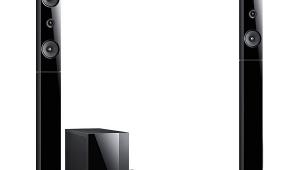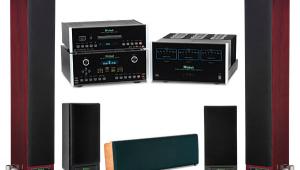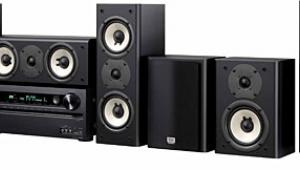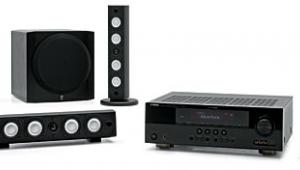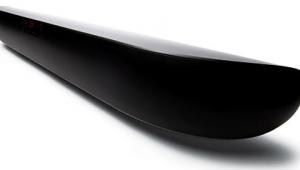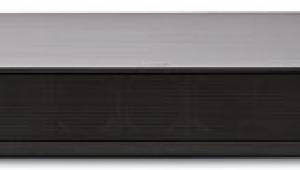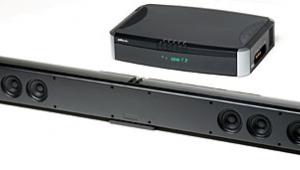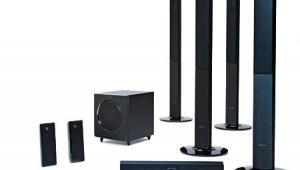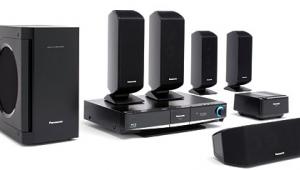Panasonic SC-ST1 & SC-HT900 HTIB Page 2

The DVD receiver's layout is so clean, you might miss the basic controls that are spread neatly across the 2-inch-deep top panel. You might also miss the limited connections on the back side: two sets of analog inputs (for TV and VCR/auxiliary), three sets of video outputs (composite, S-video, and component), and AM/FM antenna receptacles. There's also a headphone jack on the bottom, hidden from view. Unfortunately, the SC-ST1 doesn't have a digital input, so Dolby Digital programming via a satellite dish or digital-cable set-top box is out. The tether from the subwoofer climbs the back of the stand to the receiver, where a snap-on plastic cover hides it from view. That cover also obscures the video connections. The effect is a freestanding receiver, with no strings (or wires) attached.

The SC-HT900 is better-prepared for a burgeoning home theater. Here's what the SC-HT900 offers that the SC-ST1 doesn't: a five-disc player, a digital optical input, two more line outputs, black-level control, HighMAT support, and Dolby Pro Logic II. Like DTS, DPLII has become standard equipment on new receivers, but the SC-HT900 is among the first A/V products that support HighMAT, or High-Performance Media Access Technology. Matsushita and Microsoft developed this technology for quicker access to the digital music, photos, and video stored on a disc. HighMAT-compatible devices access a single file rather than going through each file in a disc's directory.
Even if DPLII's and HighMAT's relevance varies from user to user, their absence makes the SC-ST1 already seem somewhat dated. Again, it's hard to figure out why Panasonic would put newer technology in a $500 system and not in their $1,000, top-of-the-line system.
The HTIBs' remotes are identical in construction and button configuration, but the SC-HT900's remote offers more control by doubling up the functions on the bottom three rows of buttons. Whereas the SC-ST1 has separate controls for audio and zoom, the SC-HT900 combines those functions on a single button. That opens space for additional features like Custom Sound Memory, which stores the sound settings for up to 30 discs, and Quick Replay, which automatically backtracks a few seconds.

The SC-ST1 found itself in its natural habitat, in a big room (18 by 20 feet) next to a 36-inch Mitsubishi direct-view TV. A test disc revealed that both systems have a midbass bump at about 115 hertz, which helped compensate for the SC-ST1's lack of real bass. Even with the subwoofer's volume at its highest setting, response dropped off rapidly below 60 Hz and bottomed out at about 45 Hz.
The speakers weren't at all finicky about placement, although users may agonize over the convoluted delay-time settings. Too many HTIB receivers require that you compare the length between the listener and each speaker, then calculate a delay time, instead of merely entering the distance between the listener and each speaker and letting the receiver do the rest. I had to ride the SC-ST1 hard to reach adequate sound levels. I maxed out the subwoofer's volume setting to match the satellites' during system calibration. Once the movies started, I frequently had to push the master volume to its maximum setting to elicit realistic special effects. Although both systems played loud enough for my tastes, neither could register 90 decibels on a sound-level meter, even with one of the kings of home theater demo discs, The Lord of the Rings: The Fellowship of the Ring.
 The SC-ST1 maneuvered through all of the midlevel special effects in the "Wolves and Other Animals" chapter of the Dances with Wolves special-edition DVD. The rifle butt to the side of Kevin Costner's head (ouch!), the center-channel squeal of the wolf when it's hit by soldiers' bullets, gunshots, war cries, and small arms sounded OK through the SC-ST1. Large-scale explosions, discos, and some dialogue did not. In particular, dialogue could be distant and thin through the SC-ST1. At its worst, as in Jackie Chan's The Tuxedo, this system suffered from uneven off-axis response that reduced center-channel clarity. In the fight-in-the-disco scene from Antwone Fisher, the bass-heavy nightclub music sounded flabby, but the fight effects resounded crisply through the room. The opening-battle scene on the Windtalkers special-edition DVD, among the most graphic since Saving Private Ryan, was enough to make you hide your eyes in your hands. Still, the multiple explosions, while convincing, could have used more bass energy.
The SC-ST1 maneuvered through all of the midlevel special effects in the "Wolves and Other Animals" chapter of the Dances with Wolves special-edition DVD. The rifle butt to the side of Kevin Costner's head (ouch!), the center-channel squeal of the wolf when it's hit by soldiers' bullets, gunshots, war cries, and small arms sounded OK through the SC-ST1. Large-scale explosions, discos, and some dialogue did not. In particular, dialogue could be distant and thin through the SC-ST1. At its worst, as in Jackie Chan's The Tuxedo, this system suffered from uneven off-axis response that reduced center-channel clarity. In the fight-in-the-disco scene from Antwone Fisher, the bass-heavy nightclub music sounded flabby, but the fight effects resounded crisply through the room. The opening-battle scene on the Windtalkers special-edition DVD, among the most graphic since Saving Private Ryan, was enough to make you hide your eyes in your hands. Still, the multiple explosions, while convincing, could have used more bass energy.
